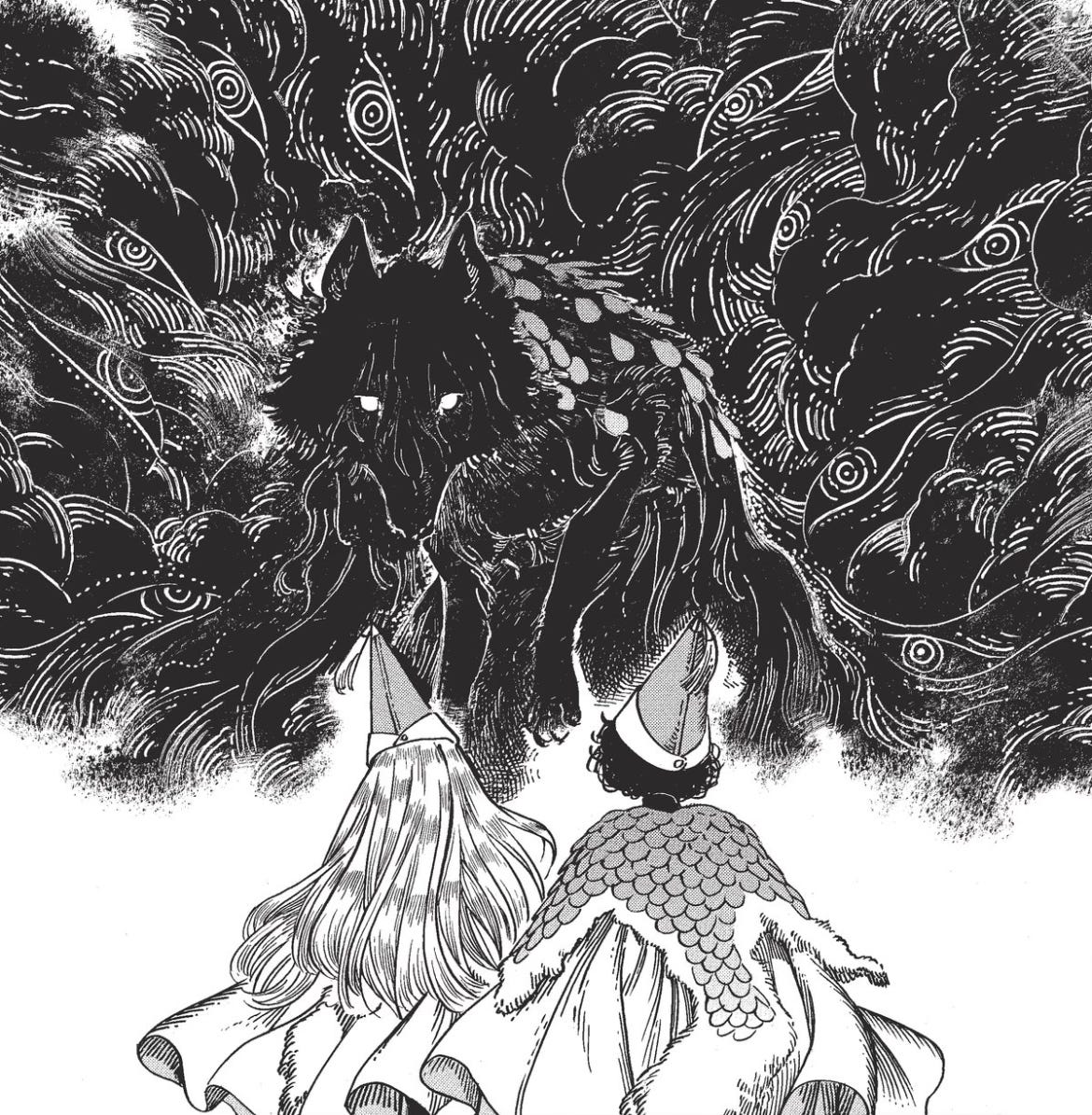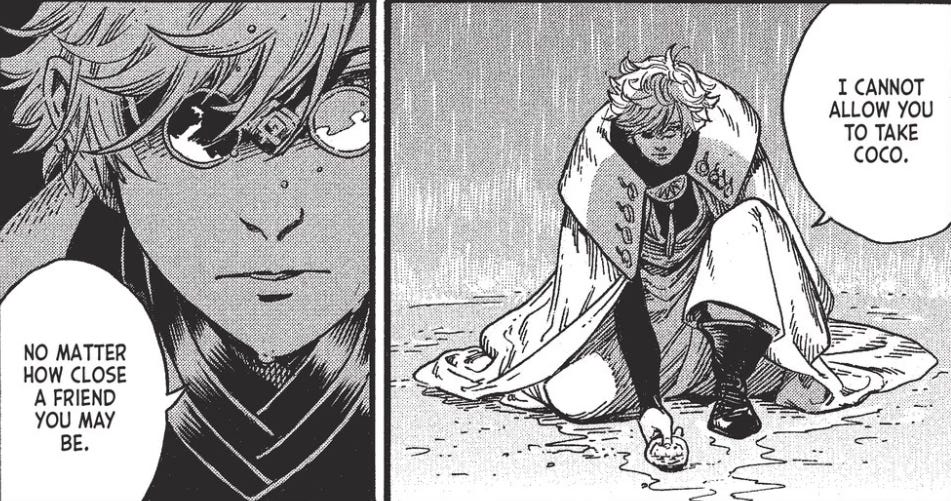Preface
A big theme that holds true across the best characters in manga—and in storytelling in general—is their unpredictability. But that’s a fine line, right? A character who does completely random things is not unpredictable so much as they are erratic and off kilter. But a character who is unpredictable, yet still aligns with their core values, that is a character that can define a story.
Witch Hat Atelier is gorgeous for so many reasons, from the art style down to the character design and world building. Yet it also possesses that enviable depth where it isn’t as simple as good guys vs bad guys. There are nuances and grey areas that make it a fascinating study in human morality.
Granted, there will always be characters who find themselves cast in a “good vs bad” structure, but it’s the characters who slip between the cracks that really add an invaluable layer to the story. One that gets readers to ask questions. Lots of questions.
Preface over!
In case I haven’t mentioned this enough, my wife and I have a frequent back-and-froth whenever Boromir is concerned. And in case you’re wondering he is often concerned because we watch Lord of the Rings at regular intervals. Extended cuts, duh, I love that cringy scene where Boromir appears over Faramir’s shoulder when Denethor is losing his mind.
I digress. I mention this because Boromir is a rare character that is worth back-and-forthing about. Both in the context of the story, and in his lasting impression.
There are other characters like this. Characters who don’t always present perfectly clearly on the morality spectrum. Who present a bit unpredictable, or enigmatic. Professor Snape, for the majority of the Harry Potter series, for instance, is unpredictable. You can have your suspicions, but can you ever know for sure what he will do, who he’s fighting for, what he cares about?
I would also add Qui-Gon Jinn to that, not from the Star Wars prequels alone, but from his role in the extended universe, particularly his relationship with Count Dooku and his head-butting with the Jedi council. There’s a lot to think about, a lot to debate what he was really capable of, what he actually believed in.
In manga, these make for the best characters—Gojo from Jujutsu Kaisen? Hisoka from Hunter X Hunter? Literally the entire cast of Hell’s Paradise? You never know what they’re going to do. You never know what they wholly stand for. Even if you feel like you can conclusively deliver a verdict on their morality, they still aren’t the “fall-in-line” type, and that unstable footing is what makes them so wonderful to think about. Same as Boromir. Same as Snape. Same as so many others.
Before we get into Witch Hat Atelier, here’s what you need to know.
Coco, a young girl who admires magic, finds her mother turned to stone one day. Without any means to free her, witches arrive and are similarly stuck. But Coco finds herself in a position to learn magic after all, and from Master Qifrey, a powerful and respected witch. But as Coco and her crew face new challenges in the world of the story, they begin to face uncertainty as to the limits of magic, with all of it tying back to Coco’s primary drive to save her mother.
And that’s all you need to know.
From the brief plot summary alone, it would make sense that there’s plenty of room for a screwball character or two to stoke the morality flames of the story. After all, the only thing stopping Coco from using forbidden magic to save her mother is the preexisting rule that forbidden magic is, well, forbidden. Thus begins her great internal dilemma. Does she abide by the rules and continue to learn magic, or does she break from the “good guys” of the story, the witch hats, and forsake their rules in the name of saving her mother?
There is no catalyst to fuel that dilemma like a character stuck between the two conflicting paths.
I didn’t necessarily expect to find out who that wild-card character was in Witch Hat Atelier, but the more I read, the more I started to realize who it was—Master Qifrey. The benevolent head of his own Atelier, the kindhearted man giving home and tutelage to four young apprentices. I only semi-jokingly referred to him as Gojo in another universe (it’s the look, mostly) but I didn’t expect him to go a similar route of not really jiving fully with the higher authorities in his universe.
That’s, in turn, what makes him such an adored character. Shirihama sensei, creator of Witch Hat Atelier, made an appearance at New York ComicCon this past year for an interview and live drawing, and when she asked the crowd at New York ComicCon to decide who she would do a live drawing of, you can guess who won—Master Qifrey.
The thing about these “wild card characters” is, as the creator, you’re really under no obligation to spell it out at any point. You don’t need to define their morality, because at its core, morality isn’t so easy to define anyway. Harry Potter does with Snape, we learn, conclusively, that he is good. Boromir dies on a good note, and can pretty conclusively be dubbed a good guy. But Qui-Gon Jinn? He’s good, sure, but his full depth, and the extent of his goodness vs badness is never outright settled on.
Master Qifrey may well be a vessel for good once and for all, just like Qui-Gon, but after his experience with Beldaruit—a witch of higher standing than even Qifrey— enough doubt was cast on his full depth that it’s much the same outcome as what we can surmise from Qui-Gon Jinn—just what is he capable of, how far will he push the boundaries, and can he be trusted?
Which leads into another benefit of these wild card characters—they introduce a general uncertainty beyond just their own immediate circle. It doesn’t take long into Witch Hat Atelier before the question is presented—is forbidden magic really that bad, and should it be as taboo as it is? The same holds true with Qui-Gon Jinn’s ongoing lore—are the Jedi really all good, if in order to be one you have to let go of all emotional attachments? Could there be a better way? And can you really blame Boromir for wanting to use evil’s power in the name of good when his perspective on “good” is so much different from his time on the literal front lines of fighting evil?
Coco’s goal is to heal her mother, who has been turned to stone. A simple objective. A “good” objective. But it appears as though the only way she might be able to do that is through using forbidden magic and separating herself from the Witch Hats forever. Which is a mighty big leap she isn’t ready to take.
Qifrey, however, being introduced as a wild card, presents an outlet for her to do so, should she choose. And since Qifrey is presenting on this unstable moral footing, we have to ask ourselves—would he ever take that step for Coco? Would he support her if she took the step? Dare I even ask, would he push her to take that step, knowing what it may do for the witch community going forward?
I would never have asked these questions before Qifrey’s encounter with Beldaruit. But now that it’s started, there’s no turning back. Which harkens back to that point I made earlier—these kinds of characters introduce a general uncertainty beyond just their own immediate circle. Once readers/viewers are introduced to nuances in your story, it opens up the possibility for more nuances.
Even if that wild card character is only there to stir the pot, get on in there and stir it. Uncertainty is such a valuable weapon in storytelling and it can all stem from that singular character.
The question I come back to: does every story need a wild-card character? Probably not. But for the life of me, all my favorite stories, all the ones I can’t forget, those are the ones with the characters like Qifrey.
Hey, creatives—I’m going to encourage you to find your wild-card character. That one person that keeps some form of uncertainty throughout the course of the narrative. If you don’t have one, look harder, maybe you do. If you really don’t, that’s okay, let’s see if you want to introduce one. The exercise is simple—use that character to introduce more uncertainty. Play with their morality. Every time they do something “good” that aligns with your protagonist, have them do something “bad” as well. The trick is for it all to align with their end goal.
Hey, fans of Witch Hat Atelier—Very simple question: just tell me what you think of Qifrey. Are you as smitten with him as me?









I liked wha, but saw it as a story for a younger demographic inti Qifrey’s story started to unfold. Now I’m shook and addicted. The guy has serious personal stakes on the line and I’m ready for him to shake things up!
I'm a big WHA fan, and Qifrey is one of my favorite characters. I agree that his moral grayness is very interesting, can't wait to see how things will turn out with him